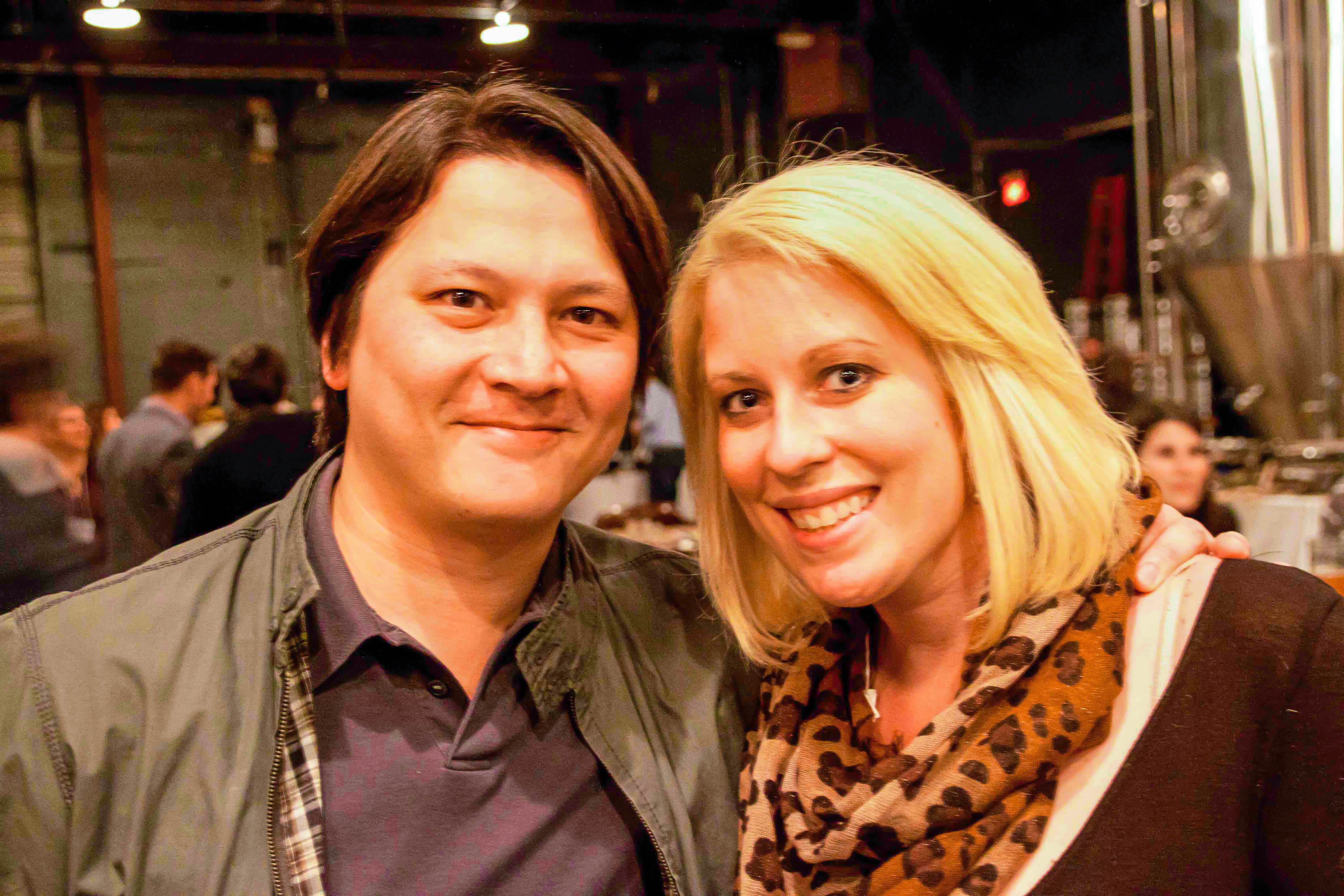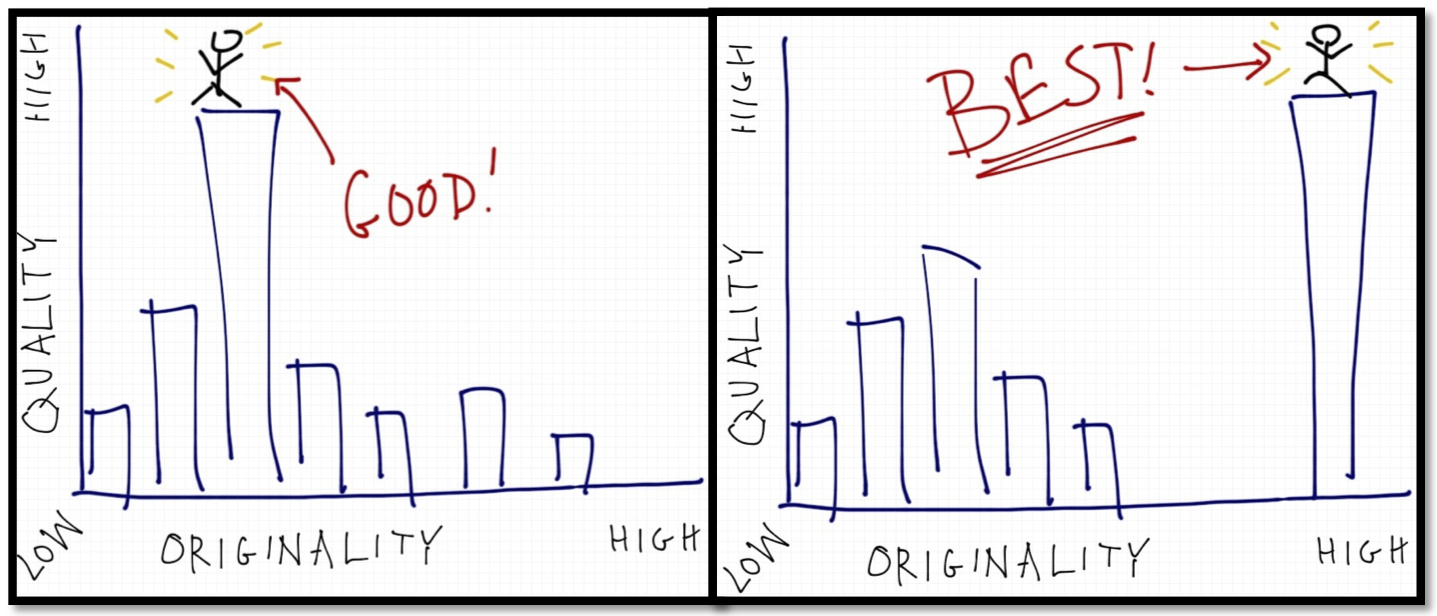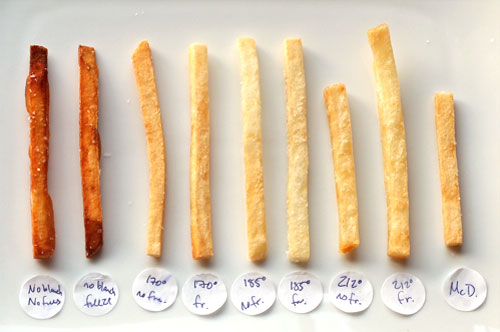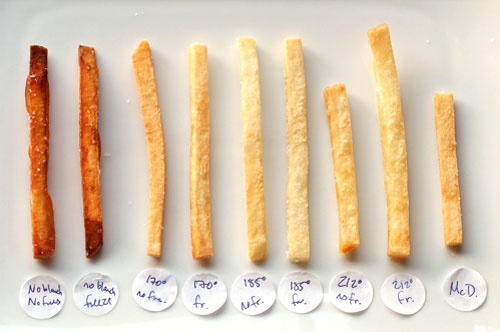loading...
The final installment of my 5-part review of Kenji Lopez-Alt’s Talk, “I’ve Got a Test for That”: Notes from the Keynote at Food Blog South (2013) ends here (see parts 1, 2, 3, & 4 if you need to catch up).
Personally, I think I’ll always have some concerns about the ways bloggers write for the Internet (especially those that are not just food bloggers, but female “lifestyle” bloggers as well: for me, these authors often raise a series of ethical issues about women’s work and the “do-ability” of our writings’ claims).
But, the flip-side of this kind of judgment is that I’ve never truly entertained how expensive and time-consuming a scientist’s experiments might be when their end-of-the-day goal is simply to write an article about food. Creating tests or charts like Kenji does below is more than a Saturday afternoon extracurricular. It’s that unique blend of “geekery,” recipes, and food writing I mentioned at the beginning of this article.
As you read Kenji’s “What Crazy Thing Can I Do?” approach to food blogging, please keep in mind that it raises some questions about the early, rudimentary ideas of what a food blog actually is. By advocating for the sometimes demanding mathematical and scientific attentions one can only do with certain resources (that is—the aid of a parent-company’s website. A company that will pay him to order everything off of the In-N-Out Burger menu, or fry covertly-attained frozen potato sticks until just the right level of “final golden-brown crispy conclusion”).
In fact, Kenji’s work participates in a new world of blogging where the most successful food and eating websites have advertisers and revenue with which to pay their writers. These are not the same at-home bloggers I mentioned in section 3 that don’t have the time to spell or fact-check before they hit “publish.”
For many critics, one of the major concerns around the changing blogosphere (see Matchar, Hilgenberg, Jacob, and Rousseau) is the issue of authenticity. Part of what makes a blog so appealing to readers centers on the idea that unlike high-power glossies like Gourmet or Bon Appétit, personally-written posts for the Internet are actually meant to be real.
Perhaps it’s our own self-published voyeurism that compels so many readers to click through our posts. And, in Kenji’s approach, I like to believe the idea of that “guy we knew in Bio Lab who was super awesome” may be a very intentional brand that generates his own niche and authenticity as an author.
And I can’t help but question this ongoing transfer of food blogging from personal web-pages (“web logs” or “blogs”) to corporate ones and wonder: are websites like Serious Eats “Food Blogs” in the traditional sense? Or, are they just the next generation of online journalism where Gourmet, the New York Times, and Bon Appétit have finally stopped “swimming against the tide” and chosen to move their publications online?
But, back to Kenji: at the beginning of his talk, he told us up front that a few of these approaches to food were, in some ways, “extreme,” but it’s part of this extremity that makes them valuable examples of how to create original, authoritative content.
[Likewise, they’re also valuable examples of how to create somewhat traditionally impossible content for the old model of an everyday blogger.]
But, these grey areas don’t make Kenji’s advice any less valuable. His maxims of originality and authority still stand because they suggest pretty ideal models for how to question such elements in our own writings.
While many women’s lifestyle blogs may offer “escapist fantasies” that I’ve certainly fallen prey to when reading, Kenji shows how traditionally scientific, “men’s work” can equally be romanticized in the form of a french fry.
Whether the blogger next door has the time to perform his experiments is another issue, but, for now, let’s simply answer his question, “What Crazy Thing Can I do?”
—
– Why So Crazy? –
The last part of Kenji’s talk is particularly fun, because it shows how his own science-minded background informs Serious Eats blog posts (plus, there are more drawings and graphs).
But before I list any of Kenji’s crazy experiments, dyed eggs, or discriminately-studied McDonald’s fries, a little perspective on his approach (triangle tests don’t just happen on food blogs):
Part of Kenji’s experiences as the Chief Creative Officer and food writer at Serious Eats can be traced to his degree from MIT. When we were first getting to know each other, Kenji was quick to point out his family of scientists, and, how, up until a certain point, he’d always thought he’d be a scientist too. It wasn’t until his own confluence of experiences in Boston-area restaurants and the Good Eater blog that food…sort of…just found him.
This must be why I enjoyed meeting Kenji for so many reasons—one, we’re both academics (not the kind of people you imagine as the “average” blogger), and, two, we come from somewhat similar stomping grounds in New England (Kenji’s from Boston, Massachusetts, and I spent a portion of my life on the southern coasts of Rockland, Maine).

Pictured: Kenji Lopez-Alt and me at the Good People Brewing Company after his Food Blog South keynote speech (January, 2013).
I found Kenji’s story particularly interesting as it somewhat reminds me of my own, since, I know what it’s like to turn your life from textbooks to tapas.
For many writers, food has this magical way of finding you.
You may be looking around, head to the ground, and really searching for something.
Tired, hungry, you make yourself dinner.
Suddenly, you wonder why you stopped thinking about the search or searching at all.
For me, at least, food and its preparation can quiet a busy mind, and the fact that you get to eat your sandwich and think about it makes the whole process extra rewarding.
Plus, knowing how to think and write about food are pretty priceless skills. So if you can bring your academic training into it, then all the better. I keep reading these blogger “advice” columns in which people suggest the secret to blogging success is constantly qualifying your posts with numbers (“5 Things” if you will), but it’s so much more complicated than that.
One of the perks of having any serious academic degree is that regardless of your field—say, science or literature—the regular, critical review of your work gradually awards you many of the skills that make for great posts on food. The fact that you were smart enough to see the bigger picture and quantify it may just be signs of your training. Simply being required to articulate your ideas regularly and specifically can only help to explain why a scientist might make for an excellent food blogger.
I’ll put it this way: food blogging can be like writing a dissertation. To be truly good at it, the post requires thoughtful analysis and a clearly developed thesis.
[No doubt, it’s this kind of logic that took me an extra week or more to hit “publish” on the umpteenth final version of this article….]
As with any dissertation, dozens before you have made their names studying the same ideas, and by the time you get to the subject, you must push beyond the conversation previously lain out before you. Otherwise, you have no notable or distinguishing markers as a thinker.
You’re just another grad student…
or, in this analogy, you’re just another “blogger.”
I find Kenji’s advice particularly useful at this juncture: to push past what’s “good” as a writer and to distinguish yourself by doing something novel and “best” for your readers.
Here, Kenji has another graph that compares the good of Internet writing to what could possibly make it the best:

Pictured: two of Kenji’s hand-drawn graphs that show the immediate difference between a blogger who writes “good” content and one who writes the “best” content.
Left: the blogger’s content is “OK” simply because it ascribes to decent levels of originality (x-axis) and higher-than-average levels of quality (y-axis). Right: high levels of originality (x-axis) and high levels of quality (y-axis) mark some of the best bloggers online; however, making these kinds of posts are not, exactly, easy to do.
When I shared this chart with Cristen Conger over at Stuff Mom Never Told You, she responded—
“That quality chart is spot on and simultaneously depressing. It never surprises me when researching even basic topics how low-quality online content often is.”
-Cristen Conger
Although doing something original may be enormously difficult and individual to each blogger, Kenji’s ideas of “going to extremes” and “testing and retesting” offer a great place for anyone to begin thinking about their own approaches and niche.
According to Kenji, what bloggers should really worry about is taking something good, and making it better, or asking yourself—
“What crazy thing can I (or we) do?”
– Kenji Lopez-Alt
And, answer in a way that distinguishes your work’s quality, originality, and expertise.
To help illustrate this idea, I’ve composed some notes from Kenji’s keynote address on many of the great examples of what he’s done, specifically, to bring new authority and perspective to Restaurant Reviews, Product Reviews, and “Best of” Recipes at Serious Eats.
For more of Kenji’s repertoire of posts, see The Food Lab or his 60 recent vegan experiences.
Example 1 – “What Crazy Thing Can I Do?”: Restaurant Reviews
Concept: “We Eat Everything” is an approach that’s significantly more thorough than a regular blogger’s review of a restaurant. Instead of dining at a place once, the blogger tests everything on the menu, distinguishing themselves as an expert in the review.
According to Kenji, “This is the post where we say, ‘who makes the best fried dumplings in Chinatown?'” Because, saying, “here are some good dumplings” just won’t do.
He continues, “We want to be able to say, ‘hey, we’re not just throwing together an arbitrary list – we actually tried every single dumpling in Chinatown ourselves, and ranked them according to very intense criteria – thickness of wrapper, crispness of frying, flavor of the filling, value, etc – and here are the results.'”
Anyone who’s familiar with online food writing can easily see the benefits of this technique: by valuing thoroughness and not being afraid to eat more than one dish, you increase your authority immediately if only because, well, you’re more informed.
Logic: Headlines indicate your writing expertise—
“Every Single Sandwich” holds greater quality and weight than, “I like this sandwich,” or “I tried this sandwich” kind of reviews.
[ Plus, Google likes it when you have authoritative content . . . but I’m not going to bring up Signe Rousseau’s discussion of search engine “Filter Bubbles” just yet. ]
Example 1: “$26 Chicken Sandwich” on “sandwich greatness” at Serious Eats
Example 2: “32 Cheap Eats we Love in Lakeview” at Serious Eats
And here’s where Kenji really sold me with his idea of “evergreen posts.” Or, posts like Alison’s Green Juice Detox that develop lives of their own amongst readers, go “viral,” and stabilize as a regularly active pages on your website.
According to Kenji,
“When it comes to headlines, ‘The Best Dumplings in Chinatown,’ is far more clickable than ‘Joe’s Shanghai Has Good Dumplings.’
And yes, it’s a lot of work to do posts like this, but in the end, it’s worth it.
They become what we call evergreen posts – posts that keep giving long after they’ve been published . . . in this model, you’ve produced an idea that people search for all the time online, but you’re apart of this equation / conversation. Over time and page views, your posts eventually stabilize, allowing for regular, consistent readership that’s driven to the page simply because of what it is. “
–Kenji Lopez-Alt
Example 2 – “What Crazy Thing Can I Do?”: Product Reviews
Concept: Popular food products like “organic” or “locally grown” offer wonderful buzz words capable of influencing eaters’ dining experiences. Whether one believes an organic egg actually tastes better than a pasteurized one is irrelevant. Powers of suggestion and the expectations of the eater can determine more of the dining experience than anything else.
Or, as Kenji noted during his talk about a past test using organic / non-organic eggs, “we discovered that people were more interested in the color of the eggs than how they actually tasted.”
Logic: The scientific method reveals flaws in human palates when placed in a “real world setting: plain, cooked, in dishes.” When study participants tasted foods in blind (and, possibly, “double-blind”) settings, the scientist (here, Kenji) was able to gain an objective understanding of how someone else actually “tasted” (or thought they tasted) the food on their plate.
Example: “Do Better Eggs Really Taste Better?” at Serious Eats

Pictured: a spliced-together 3-panel image of Kenji’s triangle test on organic and non-organice eggs. Left: both eggs unadulterated; Middle: pasteurized egg dyed bright orange; Right: organic egg dyed bright orange.
Can you guess which one the testers valued most?
After a few “umm..this one!” responses from FBS2013 attendees, Kenji revealed that the eggs in the back were always the organic ones, but inconsistently preferred by participants based on these variables in color.
Example 3 – “What Crazy Thing Can I Do?”—“The Best of” Recipes
Concept: Determine your “best ever” recipe for a dish or cuisine, then treat it as the best ever. Simple, right?
Chili—one of Google’s most searched recipes—has dozens of variations in which it “best ever” groupings have been determined at Serious Eats:
(and the list goes on and on; you can read more chili recipes at Serious Eats here).
According to Kenji,
“It’s no accident that I have seven different variations of chile on Serious Eats. You hear a lot about wealth distribution these days. How 1% of the population owns 99% of the wealth. Well it’s the same with recipe searches. Chili IS that 1% that owns 99% of the recipe search traffic.”
–Kenji Lopez-Alt
In some cases, “best of” doesn’t work in terminology, but “perfect” substitutes as well.
When Amateur Gourmet Adam Roberts spoke that morning on the “10 Food Blog Posts That’ll Get You Traffic,” he referenced his “Best Broccoli of Your Life” if only coincidentally: his recipe for roasted broccoli (like the “best of” recipes Kenji compiles above) changed his mind entirely on how broccoli should taste. It, literally, was the “best broccoli of his life.”
Example: PERFECT FRENCH FRIES
Here, Kenji uses a bag of covertly-attained frozen McDonald’s french fries as a way to determine exactly how the recipe would work if you were able to make them at home.
Part of the McDonald’s formula lies in the frozen, pre-made perfection of their product before it ever hits a McDonald’s. According to Kenji, “I find it remarkable that the bigwigs have discovered a way to create a frozen fry that even a one armed eyeless chimp has trouble screwing up.“
And, although frying french fries might be simple, Kenji’s approach to their “crispy brown perfection” is not. Turns out, he has a test for that:

Pictured: Kenji’s results on the road to discovering the “perfect french fry” at home that meet McDonald’s standards of color, flavor, and salt.
When testing his recipe, Kenji prepared 43 batches within 72-hours, defining the “perfect” french fry as
“The exterior must be crisp, not tough . . . the interior must be fluffy and have a strong potato flavor . . . they must be an even light golden blond. . . they must stay crisp and tasty for at least as long as it takes to eat a full serving.”
– Kenji Lopez-Alt
And these standards are hilarious if only because they’re true.
When I was incredibly young, my mother used to pickup McDonald’s Happy Meals on our way home from “Daisies” (the pre-Brownies, pre-Girl Scouts league), and we’d sit in the car, practically dying to eat the french fries. Just waiting until we got home seemed like a challenge, because, even though the drive was short, the fries were not the same when you opened the bag at home.
But knowing “why” McDonald’s french fries deteriorate after a given time, and, at what temperature their results can be made at home is silly, scientific, and just plain impressive.
Kenji detailed the experience as a “mystery novel: quest, colorful characters, dark realities, and final golden-brown crispy conclusion.”
By using his unique blend of geekery and food writing, Kenji applies “high journalistic standards for silly things”
The results? Well, you’ll have to read the full post for everything his research reveals.
—
– Final Thoughts –
If you’ve gotten this far, then you’re probably overwhelmed by the vast amounts of information Kenji shared with FBS2013 (that’s right, this was originally a keynote address, just in case you forgot). And there’s tons of fun facts and ideas that I didn’t (or couldn’t) include here.
Honestly, it’s almost impossible to sum up a keynote speech that covers so much territory at once. In fact, when making final revisions to this post, “Part 5,” it occurred to me that the last section should have been divided into three individual posts (one for advice on product reviews, one for recipes…you get the picture).
But there’s a reason why one post should (or could) be three, and that a keynote review had to be broken into so many entries here at Clearly Delicious, if only, because—
“As a food blogger who wants to have authority, you have to do the work.”
–Kenji Lopez-Alt, Serious Eats
Here concludes Part 5. Thanks, Kenji.
—
Directory:
Or, See: Part 1: “I’ve Got a Test for That”
Part 3: “The Good, the Bag, & the Plain Weird”
Part 4: “The Architecture of a Good Blog Post”
Part 5: “What Crazy thing Can I Do?” (above)
—
Follow me on Pinterest: http://pinterest.com/helana/
Twitter: https://twitter.com/DancesWLobsters
Facebook: https://www.facebook.com/pages/Clearly-Delicious/103136413059101
Tumblr: http://clearlydelicious.tumblr.com/
Instagram: http://instagram.com/helanabrigman
Part 5: "What Crazy Thing Can I Do?" Kenji Lopez-Alt of Serious Eats,


No Comments